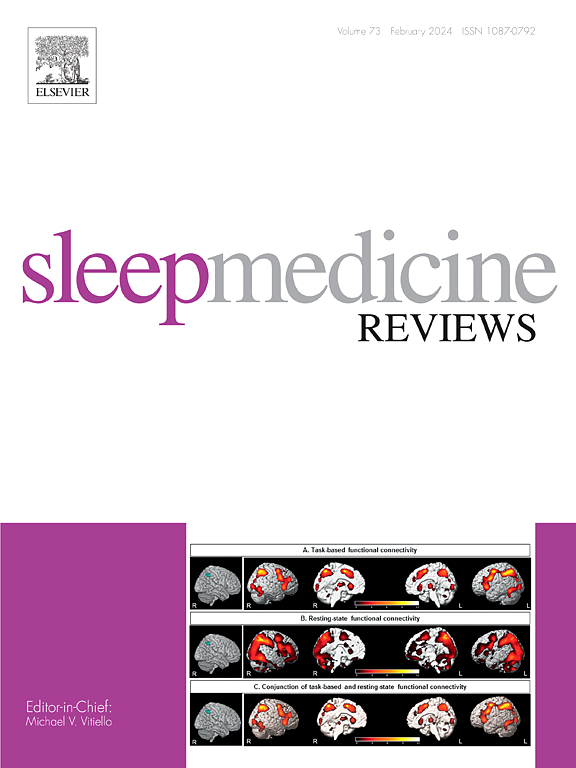Effects of sleep hygiene education for insomnia: A systematic review and meta-analysis
IF 9.7
1区 医学
Q1 CLINICAL NEUROLOGY
引用次数: 0
Abstract
Sleep hygiene education (SHE) as a single therapy for insomnia still lacks sufficient evidence. This study aimed to quantify the effects of SHE on insomnia treatment. A literature search was conducted on seven databases from inception up to 30 September 2024 to retrieve randomized controlled trials. Meta-analyses were performed to estimate the mean difference (MD) of Insomnia Severity Index (ISI) (primary outcome) using a random-effects model. Risk of Bias 2 tool was applied to measure methodological quality. Forty-two RCTs encompassing 4245 adults (65.5 % female) were included. The pooled results showed significant pretreatment-to-posttreatment improvement in ISI score (MD = 3.4, 95 % confidence interval (CI) [2.08, 4.64]). However, SHE was inferior as a cognitive behavioral therapy for insomnia (CBT-I) (MD = 3.8, 95 % CI [2.92, 4.76]), partial CBT-I (MD = 4.5, 95 % CI [3.33, 5.60]), exercises (MD = 2.9, 95 % CI [0.81, 5.04]), and acupressure (MD = 1.9, 95 % CI [0.82, 3.00]) regarding the ISI score. The majority of included trials (85.71 %) had a high overall risk of bias, and the remaining had “some concerns.” Future work is encouraged to generate robust evidence through the development of well-designed SHE as an examined intervention for insomnia that involves process evaluation and treatment fidelity.
睡眠卫生教育对失眠的影响:一项系统回顾和荟萃分析
睡眠卫生教育作为一种治疗失眠的单一方法,目前仍缺乏足够的证据。本研究旨在量化SHE对失眠治疗的影响。从建立到2024年9月30日,对7个数据库进行文献检索,检索随机对照试验。采用随机效应模型进行meta分析,估计失眠严重指数(ISI)(主要结局)的平均差异(MD)。采用Risk of Bias 2工具测量方法学质量。纳入42项随机对照试验,包括4245名成年人(65.5%为女性)。合并结果显示,治疗前ISI评分较治疗后显著改善(MD = 3.4, 95%可信区间(CI)[2.08, 4.64])。然而,SHE作为失眠(CBT-I) (MD = 3.8, 95% CI[2.92, 4.76])、部分CBT-I (MD = 4.5, 95% CI[3.33, 5.60])、运动(MD = 2.9, 95% CI[0.81, 5.04])和穴位按压(MD = 1.9, 95% CI[0.82, 3.00])的认知行为疗法在ISI评分方面表现较差。大多数纳入的试验(85.71%)总体偏倚风险较高,其余试验存在“一些担忧”。鼓励未来的工作通过开发精心设计的SHE作为失眠的检查干预来产生强有力的证据,包括过程评估和治疗保真度。
本文章由计算机程序翻译,如有差异,请以英文原文为准。
求助全文
约1分钟内获得全文
求助全文
来源期刊

Sleep Medicine Reviews
医学-临床神经学
CiteScore
20.10
自引率
3.80%
发文量
107
期刊介绍:
Sleep Medicine Reviews offers global coverage of sleep disorders, exploring their origins, diagnosis, treatment, and implications for related conditions at both individual and public health levels.
Articles comprehensively review clinical information from peer-reviewed journals across various disciplines in sleep medicine, encompassing pulmonology, psychiatry, psychology, physiology, otolaryngology, pediatrics, geriatrics, cardiology, dentistry, nursing, neurology, and general medicine.
The journal features narrative reviews, systematic reviews, and editorials addressing areas of controversy, debate, and future research within the field.
 求助内容:
求助内容: 应助结果提醒方式:
应助结果提醒方式:


